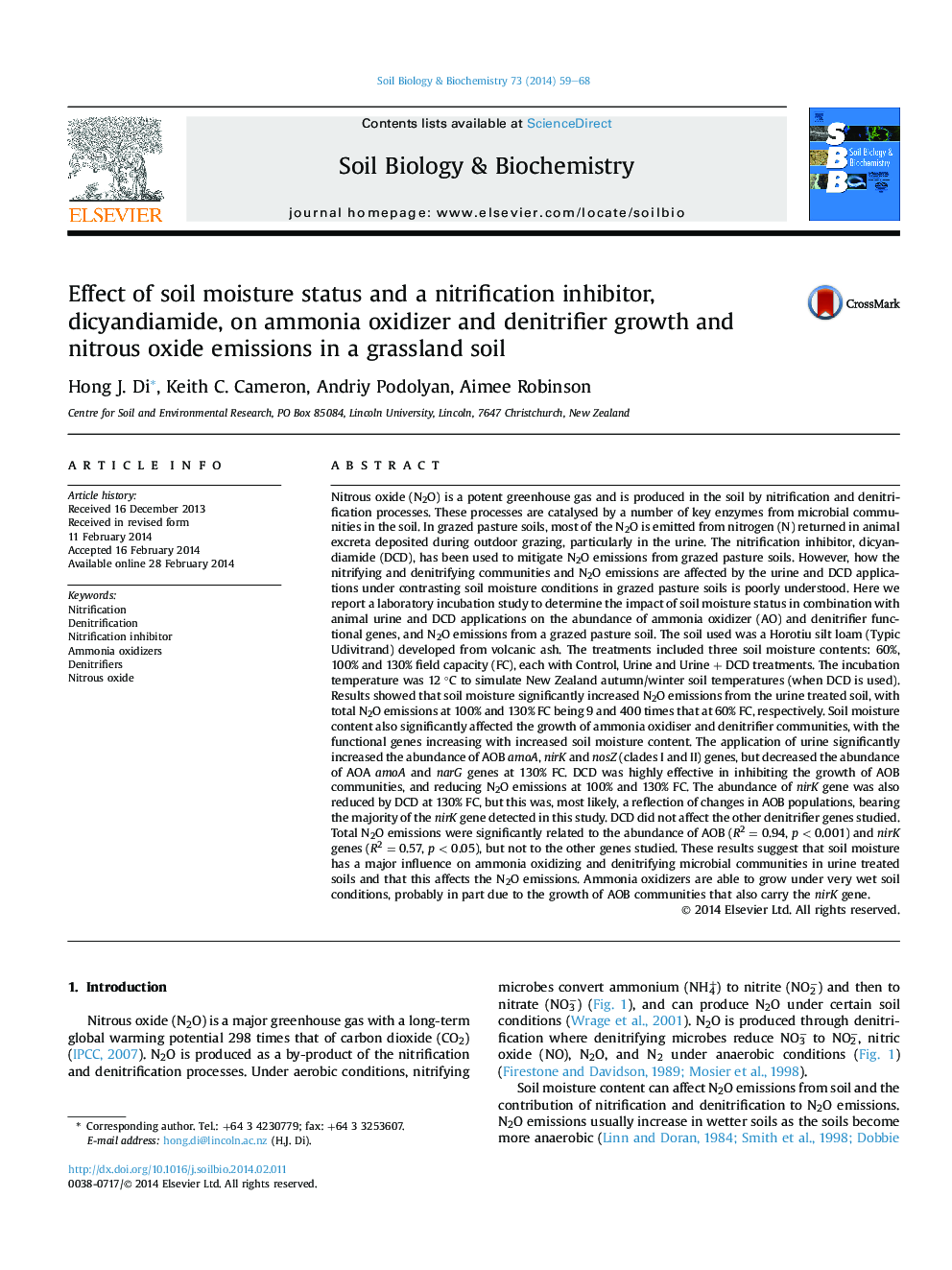| کد مقاله | کد نشریه | سال انتشار | مقاله انگلیسی | نسخه تمام متن |
|---|---|---|---|---|
| 2024661 | 1542611 | 2014 | 10 صفحه PDF | دانلود رایگان |
• Soil moisture status affected the growth of ammonia oxidiser and denitrifier communities.
• The application of urine significantly increased the abundance of AOB amoA, nirK and nosZ (clades I and II) genes.
• Animal urine decreased the abundance of AOA amoA and narG genes.
• The abundance of AOB and nirK gene was reduced by the nitrification inhibitor dicyandiamide.
• N2O emissions were related to the abundance of AOB and nirK genes but not to the other genes studied.
Nitrous oxide (N2O) is a potent greenhouse gas and is produced in the soil by nitrification and denitrification processes. These processes are catalysed by a number of key enzymes from microbial communities in the soil. In grazed pasture soils, most of the N2O is emitted from nitrogen (N) returned in animal excreta deposited during outdoor grazing, particularly in the urine. The nitrification inhibitor, dicyandiamide (DCD), has been used to mitigate N2O emissions from grazed pasture soils. However, how the nitrifying and denitrifying communities and N2O emissions are affected by the urine and DCD applications under contrasting soil moisture conditions in grazed pasture soils is poorly understood. Here we report a laboratory incubation study to determine the impact of soil moisture status in combination with animal urine and DCD applications on the abundance of ammonia oxidizer (AO) and denitrifier functional genes, and N2O emissions from a grazed pasture soil. The soil used was a Horotiu silt loam (Typic Udivitrand) developed from volcanic ash. The treatments included three soil moisture contents: 60%, 100% and 130% field capacity (FC), each with Control, Urine and Urine + DCD treatments. The incubation temperature was 12 °C to simulate New Zealand autumn/winter soil temperatures (when DCD is used). Results showed that soil moisture significantly increased N2O emissions from the urine treated soil, with total N2O emissions at 100% and 130% FC being 9 and 400 times that at 60% FC, respectively. Soil moisture content also significantly affected the growth of ammonia oxidiser and denitrifier communities, with the functional genes increasing with increased soil moisture content. The application of urine significantly increased the abundance of AOB amoA, nirK and nosZ (clades I and II) genes, but decreased the abundance of AOA amoA and narG genes at 130% FC. DCD was highly effective in inhibiting the growth of AOB communities, and reducing N2O emissions at 100% and 130% FC. The abundance of nirK gene was also reduced by DCD at 130% FC, but this was, most likely, a reflection of changes in AOB populations, bearing the majority of the nirK gene detected in this study. DCD did not affect the other denitrifier genes studied. Total N2O emissions were significantly related to the abundance of AOB (R2 = 0.94, p < 0.001) and nirK genes (R2 = 0.57, p < 0.05), but not to the other genes studied. These results suggest that soil moisture has a major influence on ammonia oxidizing and denitrifying microbial communities in urine treated soils and that this affects the N2O emissions. Ammonia oxidizers are able to grow under very wet soil conditions, probably in part due to the growth of AOB communities that also carry the nirK gene.
Journal: Soil Biology and Biochemistry - Volume 73, June 2014, Pages 59–68
